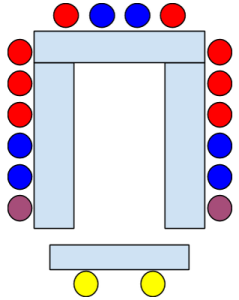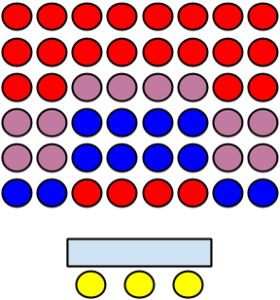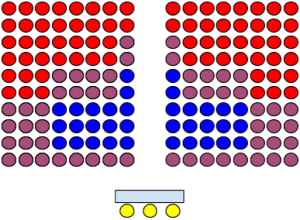 Throughout your Model U.N. career, you’ll hear again and again about public speaking, researching your topic, resolution writing, and more. However, there are many little things that can make a big impact on your experience at a conference. As part of our series on Advanced Model UN tips, we’ll run through some of these little things to help you maximize your potential as a delegate. We’ve all experienced the frustration of not getting called on enough in committee, and one of the root causes of this is the chair not being able to see you! By strategically placing yourself in the proper seat in your committee room, you can help remedy this problem and be a more active member of your committee. For the following charts, please use this Key as a general guide. Not all committees come in the same shapes and sizes, but the general ideas from these charts can be applied to almost any committee you’ll come across in your M.U.N. career. Note that a circle can represent 1 seat for single delegate committees, or 2 seats for double delegate committees.
Throughout your Model U.N. career, you’ll hear again and again about public speaking, researching your topic, resolution writing, and more. However, there are many little things that can make a big impact on your experience at a conference. As part of our series on Advanced Model UN tips, we’ll run through some of these little things to help you maximize your potential as a delegate. We’ve all experienced the frustration of not getting called on enough in committee, and one of the root causes of this is the chair not being able to see you! By strategically placing yourself in the proper seat in your committee room, you can help remedy this problem and be a more active member of your committee. For the following charts, please use this Key as a general guide. Not all committees come in the same shapes and sizes, but the general ideas from these charts can be applied to almost any committee you’ll come across in your M.U.N. career. Note that a circle can represent 1 seat for single delegate committees, or 2 seats for double delegate committees.
Board Room Setup (Small Committees) 
Classroom Setup (Medium Sized Committees)  Possibly the most common setup for your Model UN simulations will be a classroom setup. These committee arrangements are pretty straightforward, but can often be crowded, making it especially important to sit toward the front of the room. By sitting in the middle, you’re in the central field of vision for your Chair and also signal that you want to be engaged and in the fray of conversation. By sitting in the middle (but toward the front, so your placard isn’t obscured by several others), you also place yourself strategically for working with people from any part of the room during unmoderated caucuses. As stated earlier, it’s ill advised to sit front and center of the Dais, however being off to the side allows you to have the same proximity, while also being set aside from the center for when the Chair decides to diversify where he’s choosing to look for potential speakers. It’s especially critical in medium and large committees to not sit toward the back; not only does this make it hard to see your placard, but it can also signal to the Dais and other delegates that you aren’t as serious about participation in your committee.
Possibly the most common setup for your Model UN simulations will be a classroom setup. These committee arrangements are pretty straightforward, but can often be crowded, making it especially important to sit toward the front of the room. By sitting in the middle, you’re in the central field of vision for your Chair and also signal that you want to be engaged and in the fray of conversation. By sitting in the middle (but toward the front, so your placard isn’t obscured by several others), you also place yourself strategically for working with people from any part of the room during unmoderated caucuses. As stated earlier, it’s ill advised to sit front and center of the Dais, however being off to the side allows you to have the same proximity, while also being set aside from the center for when the Chair decides to diversify where he’s choosing to look for potential speakers. It’s especially critical in medium and large committees to not sit toward the back; not only does this make it hard to see your placard, but it can also signal to the Dais and other delegates that you aren’t as serious about participation in your committee.
Assembly Setup (Large Committees) 
Extra Tips While the set-up of the seats in committee is important, so is where all the delegates in your committee sit. While the above charts work for full committees, it’s important to take into account which seats are taken, and which seats are left open. If you sit in a space toward the front or middle of the room, but without other delegations to either side of you, you get to dominate that space in the Chair’s vision. In assemblies this is especially important; to try to be equal with who gets called on, Chairs normally devise some kind of system where they divide the room into parts and rotate through those sections. Often this means splitting the room in half based on the aisle down the middle of the room, and switching back and forth between each side. Now, imagine a situation where you see 50 delegates sitting in one half of the room, and only 24 in the other? By sitting on the side with only 24 delegates, you may be able to get called on almost twice as often as if you sat on the other side of the room. Ultimately, the main takeaway from all of this is one thing: pay attention. Don’t just sit in a seat randomly, instead try to think through where you can get the most opportunity to represent your country. If a seat isn’t working for you, try to switch it up for next session! In the world of Model U.N., put yourself in the best place for your knowledge, your abilities, and your ideas to make the greatest impact possible.

